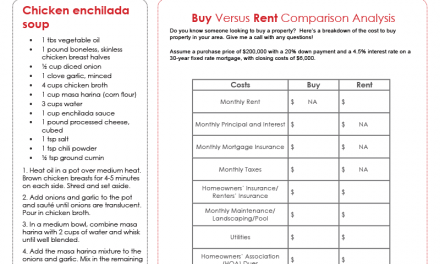As interest rates rebound from their historic lows during the pandemic, buyer purchasing power is taking a dive.
With this context in mind, carryback financing will become more popular as rates move along their climb. But before diving into a carryback financing agreement, it’s important for agents to consider the disclosures behind this type of financing structure. Since interest rates have just ended their 30-year fall, real estate professionals had little need to investigate this financing structure. A refresh is in order.
Related article:
Consider a seller who is willing to partially finance the sale of their one-to-four unit residential property by carrying back a mortgage. The seller’s agent locates a qualified prospective buyer who is not represented by a buyer’s agent. The agent prepares an offer on a purchase agreement form and presents it to the buyer for their approval and signature. [See RPI Form 150]
The terms offered for payment of the purchase price include a carryback mortgage, to be executed by the buyer in favor of the seller, for the amount of the price remaining to be paid after the down payment and an assumption of the existing mortgage on the property.
The seller’s agent also prepares a Financial Disclosure Statement addressing the carryback mortgage, also known as a carryback disclosure statement, and attaches it to the purchase agreement as an addendum. The addendum contains numerous statements about the financial, legal and related risk-of-loss aspects of the carryback mortgage. If the statement is not included as an addendum to the purchase agreement, a statutory further approval contingency allows for later cancellation of the transaction. [See RPI Form 300]
The information entered in the carryback disclosure statement is based on the terms of the:
- purchase offer;
- title conditions;
- activities to be undertaken by the buyer and seller in escrow; and
- information obtained from the buyer.
Further, the carryback disclosure statement contains only the legislatively mandated minimum disclosures.
Besides confirming delivery of the carryback disclosure statement to the buyer and the seller, the seller’s agent, and any buyer’s agent involved, need to also confirm that their respective clients understand the risks and consequences which rise out of the financial and legal aspects of the carryback transaction.
In addition to preparing a carryback disclosure statement, the seller’s agent makes separate disclosures regarding conditions of the property which might also affect decisions of the buyer or the seller in the sales transaction. Also, both agents have a duty to disclose their knowledge about the tax aspects of the carryback transaction to their client based on:
- the type of property being sold; and
- the agent’s willingness to express an opinion on the subject
One-to-four unit carryback transactions
All brokers in transactions for the purchase of one-to-four unit residential property involving seller carryback financing are mandated by statute to:
- prepare a carryback disclosure statement; and
- present it to both the buyer and seller for their review and signatures.
On the sale of other types of property, disclosures regarding aspects of carryback financing concerning material facts unknown to the client are imposed by case law.
Even the use of a masked security device requires a written carryback disclosure statement before the buyer takes possession of the property. Examples of a masked security device requiring carryback disclosure include:
- a land sales contract;
- a lease-option; or
- an unexecuted purchase agreement with interim occupancy.
When structuring a carryback sale using alternative documentation, the written disclosure statement informs the buyer and the seller about the extent of the risks presented by failing to use grant deeds, notes and trust deeds to evidence the installment sale.
On the sale of a one-to-four unit residential property, any installment sale arrangements created to accommodate the buyer’s deferred payment of the purchase price requires a written carryback disclosure statement if the carryback arrangements include:
- interest or other finance charges;
- five or more installments running beyond one year;
- an installment land sales contract;
- a purchase lease-option or a lease-option sale;
- a trust deed note given to adjust equities in an exchange of properties; or
- an all-inclusive trust deed (AITD) note.
Carryback disclosure statements are optional in carryback transactions creating straight notes which do not:
- bear interest; or
- include finance charges.
However, carryback disclosures for straight notes need to be prepared and reviewed with the client as a matter of good brokerage practice. The risks and issues for the buyer and seller under a straight note are similar and the duty owed the client is the same.
Consider a real estate agent who is acting as a property manager or leasing agent for the landlord of a single family residence (SFR) the landlord wants to sell.
A prospective tenant makes an offer to lease the property. The offer contains an option to purchase the property on expiration of the lease. The terms for payment of the price under the proposed option include:
- a carryback note, entered into by the tenant on exercise of the purchase option for the balance of the seller’s equity in the property after the down payment; and
- a credit toward the price and down payment on the property equal to part or all of the rent paid by the tenant.
Here, the prospective tenant’s offer to lease is coupled with a purchase option which includes a monthly credit toward the price. As applied, the credit builds up equity in the property for the buyer. As with a sales transaction involving a carryback mortgage, the agent prepares the mandated carryback financing disclosures on a written form as an addendum to the lease-option.
Who prepares the disclosure?
A carryback disclosure statement is prepared and submitted to all buyers and sellers in a carryback transaction on one-to-four unit residential property by:
- the real estate broker or their agent who negotiated the carryback sales transaction and prepared the buyer’s purchase offer; or
- the buyer or seller who is a real estate licensee or attorney when neither the buyer nor the seller is represented by a broker.
When both the buyer and seller are represented by different brokers, the carryback disclosure statement is prepared by the broker or agent who prepared the buyer’s offer.
Many participants in a carryback transaction are not required to make carryback disclosures, including:
- escrow officers;
- an attorney representing a buyer or seller who is not also acting as a real estate licensee in the transaction; and
- buyers and sellers acting without the assistance of a broker, unless they are real estate licensees or licensed attorneys.














